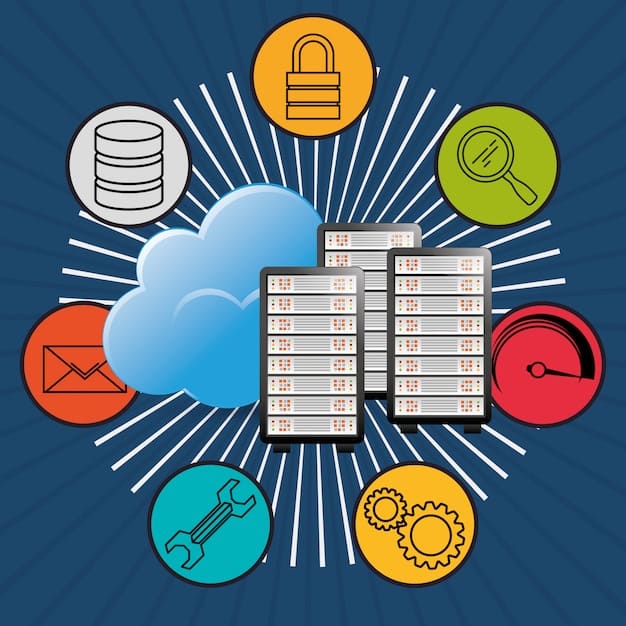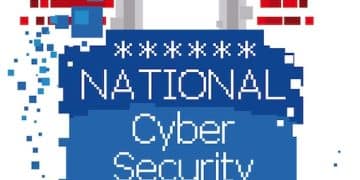Cloud Security Breaches: Prevent Unauthorized Access & Data Loss in US

Proactively mitigating cloud security breaches: how to prevent unauthorized access and data loss in the US involves a multi-layered approach combining robust technical controls, continuous monitoring, and a strong security culture to safeguard sensitive information from evolving cyber threats.
In an increasingly interconnected digital landscape, the specter of cloud security breaches: how to prevent unauthorized access and data loss in the US looms large, threatening businesses and individuals alike. The migration of critical data and operations to cloud environments offers unparalleled flexibility and scalability, yet it also introduces a unique set of vulnerabilities that demand vigilant attention. This comprehensive guide delves into the core challenges of cloud security, providing actionable strategies and best practices to fortify your defenses and protect your valuable assets in the United States.
Understanding the Landscape of Cloud Security Breaches in the US
Cloud security breaches represent a significant threat to organizations across the United States. These incidents can range from sophisticated cyberattacks orchestrated by state-sponsored actors to simple misconfigurations that leave data exposed. Understanding the common vectors and motivations behind these breaches is the first critical step toward building effective defenses.
The scale and frequency of cloud breaches have escalated dramatically as more enterprises embrace cloud-first strategies. Attackers constantly refine their methods, exploiting weaknesses in identity and access management, vulnerable APIs, and human error. Beyond the immediate financial costs, breaches can inflict severe reputational damage, erode customer trust, and trigger extensive regulatory fines, particularly given stringent US data protection laws.
Common Attack Vectors and Their Implications
Attackers often target specific vulnerabilities inherent to cloud architectures. These can include exposed storage buckets, insecure interfaces, shadow IT practices, and stolen credentials. Each vector presents a unique challenge, demanding tailored preventive measures.
- Misconfigurations: Often the leading cause, stemming from human error in setting up cloud services, leaving ports open or storage publicly accessible.
- Weak Identity and Access Management (IAM): Inadequate controls over user permissions and authentication mechanisms allow unauthorized users to gain entry.
- Insecure APIs: Poorly secured Application Programming Interfaces (APIs) can provide direct pathways for attackers to access, alter, or exfiltrate data.
- Insider Threats: Malicious or negligent actions by current or former employees who have legitimate access to cloud resources.
The implications of these breaches extend far beyond financial losses. Companies can face prolonged operational disruptions, loss of intellectual property, and severe damage to their brand equity. For consumers, data breaches can lead to identity theft, financial fraud, and a profound sense of vulnerability.
The Evolving Threat Landscape
The cloud threat landscape is dynamic, constantly evolving with new attack techniques and sophisticated malware. Organizations must remain agile, adapting their security postures to counter emerging threats such as advanced persistent threats (APTs), ransomware-as-a-service, and supply chain attacks targeting cloud service providers or their vendors.
Staying informed about the latest vulnerabilities and attack trends is paramount. This includes subscribing to threat intelligence feeds, participating in security communities, and regularly auditing cloud environments for new risks. Proactive threat hunting and incident response planning are essential components of a robust cybersecurity strategy.
In essence, preventing cloud security breaches requires a holistic understanding of the threats, a commitment to continuous improvement, and the implementation of comprehensive security controls that address both technical vulnerabilities and human factors.
Establishing a Robust Cloud Security Framework
A strong cloud security framework is the bedrock for preventing unauthorized access and data loss. It outlines the policies, procedures, and technologies necessary to protect cloud environments effectively. This framework should be comprehensive, tailored to the organization’s specific needs, and aligned with industry best practices and regulatory requirements.
Building such a framework involves several key components, starting with a clear understanding of shared responsibility between the cloud service provider (CSP) and the customer. While CSPs secure the underlying infrastructure, customers are responsible for securing their data, applications, and configurations within that infrastructure. This distinction is crucial for defining security boundaries and assigning ownership.
Defining Clear Policies and Procedures
Robust security policies must be established to govern data handling, access controls, incident response, and compliance. These policies should be clearly communicated to all employees and regularly reviewed and updated to reflect changes in the threat landscape or business operations. Procedures then translate these policies into actionable steps.
- Data Governance Policies: Dictate how data is classified, stored, accessed, and retained, including encryption requirements for data at rest and in transit.
- Access Control Policies: Define who can access what resources, under what conditions, and how their identities are authenticated and authorized.
- Incident Response Plans: Outline detailed steps for detecting, analyzing, containing, eradicating, recovering from, and post-analyzing security incidents.
- Compliance and Regulatory Policies: Ensure adherence to industry-specific regulations (e.g., HIPAA, GDPR, PCI DSS) and US federal/state laws.
These policies provide a structured approach to security, ensuring consistency and accountability across the organization. Without clear guidelines, security efforts can become fragmented and ineffective, leaving gaps that attackers can exploit.
Implementing Security Best Practices and Standards
Beyond internal policies, organizations should adopt widely recognized security frameworks and standards. Frameworks like NIST Cybersecurity Framework, ISO 27001, and CSA STAR provide structured approaches to managing cybersecurity risks. Adherence to these standards demonstrates a commitment to security and often strengthens compliance efforts.
Regular security audits and assessments are vital to ensure that implemented controls are effective and that the framework remains robust. Penetration testing and vulnerability scanning can uncover weaknesses before malicious actors do, providing valuable insights for continuous improvement. The goal is to create a proactive security posture rather than a reactive one.
A well-defined and rigorously implemented cloud security framework serves as the blueprint for securing your cloud assets, providing the foundational elements necessary to withstand the diverse and evolving array of cyber threats.

Identity and Access Management (IAM) as a Cornerstone
Effective Identity and Access Management (IAM) is arguably the most critical component of cloud security. It dictates who can access what resources, under what conditions, and plays a fundamental role in preventing unauthorized access. A breach of IAM controls often provides attackers with the keys to the kingdom, allowing them to move laterally and exfiltrate sensitive data.
In cloud environments, where traditional network perimeters are dissolved, identity becomes the new perimeter. Organizations must implement stringent IAM policies and technologies to ensure that only authenticated and authorized users and services can interact with cloud resources. This includes not just human users but also applications, services, and devices.
Principle of Least Privilege and Role-Based Access Control (RBAC)
The principle of least privilege dictates that users, applications, and services should only be granted the minimum necessary permissions to perform their specific tasks. This minimizes the potential damage if an account is compromised. Implementing Role-Based Access Control (RBAC) is a practical way to enforce this principle.
- Role Definition: Define specific roles within the organization (e.g., “Developer,” “Auditor,” “Administrator”) with predefined sets of permissions.
- User Assignment: Assign users to appropriate roles based on their job functions, ensuring they only have access to resources relevant to their duties.
- Regular Review: Periodically review roles and permissions to ensure they remain appropriate as job responsibilities change or as employees leave the organization.
RBAC simplifies access management by grouping users with similar access needs into roles. It reduces the likelihood of over-provisioning permissions, which is a common source of security vulnerabilities. This structured approach to access management enhances security and compliance.
Multi-Factor Authentication (MFA) and Strong Authentication
Layering authentication with Multi-Factor Authentication (MFA) adds a crucial layer of security beyond traditional passwords. MFA requires users to present two or more verification factors before granting access, significantly reducing the risk of credential compromise. This can include something you know (password), something you have (phone, hardware token), or something you are (biometrics).
For sensitive cloud resources, strong authentication mechanisms are non-negotiable. Implementing MFA for all cloud console logins, administrative accounts, and critical applications should be a top priority. Additionally, encouraging the use of strong, unique passwords and integrating with enterprise identity providers can further bolster authentication security.
Regular auditing of IAM logs can help detect anomalous behavior, such as unusual login attempts or access patterns, enabling quick response to potential threats. A well-managed IAM system is fundamental to securing cloud operations and data.
Data Encryption and Data Loss Prevention (DLP)
Encryption is a vital cryptographic control for data protection, rendering information unreadable to unauthorized parties. In the cloud, data exists in various states—at rest (stored), in transit (moving across networks), and in use (being processed). Each state requires appropriate encryption measures to prevent unauthorized access and data loss. Data Loss Prevention (DLP) solutions complement encryption by identifying, monitoring, and protecting sensitive data wherever it resides.
Without robust encryption, even if an attacker bypasses perimeter defenses, the exfiltrated data remains unreadable and unusable. DLP, on the other hand, acts as a preventative measure, stopping sensitive data from leaving authorized environments in the first place, whether accidentally or maliciously.
Encrypting Data at Rest and in Transit
Implementing strong encryption policies for data at rest and in transit is foundational for cloud security. Cloud providers offer various encryption options, including server-side encryption with service-managed keys or customer-managed keys (CMK), and client-side encryption.
- Data at Rest: Automated encryption of storage volumes, databases, backups, and object storage buckets. Utilizing CMKs gives organizations greater control over their encryption keys.
- Data in Transit: Secure Sockets Layer/Transport Layer Security (SSL/TLS) for data moving between user devices and cloud services, and Virtual Private Networks (VPNs) for secure connectivity between on-premises networks and cloud environments.
Organizations should also implement robust key management strategies. This includes securely storing encryption keys, rotating them regularly, and ensuring access to keys is strictly controlled. Mismanaging encryption keys can negate the benefits of encryption itself.
Implementing Data Loss Prevention (DLP) Solutions
DLP solutions monitor and control the movement of sensitive data, preventing it from leaving the organization’s control. These solutions can identify patterns of sensitive information (e.g., credit card numbers, social security numbers) and enforce policies that block unauthorized transfers, alert administrators, or encrypt data automatically.
DLP can be applied at various points: at endpoints (laptops, desktops), in networks (email, web traffic), and in storage (cloud storage, databases). A comprehensive DLP strategy integrates these different control points to create a pervasive defense against data exfiltration. Regular tuning of DLP policies is necessary to avoid false positives and ensure accurate identification of sensitive data.
By combining strong encryption with proactive DLP measures, organizations can significantly reduce the risk of sensitive data falling into the wrong hands, even in the event of a sophisticated breach.
Network Security and Vulnerability Management
Effective network security provides a crucial layer of defense, controlling traffic flow and preventing unauthorized access to cloud resources. This involves implementing virtual firewalls, network segmentation, and intrusion detection/prevention systems (IDS/IPS). Complementary to network security, robust vulnerability management ensures that systems are regularly scanned and patched for known weaknesses before they can be exploited.
In a cloud environment, traditional perimeter-based security transforms into a more distributed model, requiring granular controls at every layer. Misconfigured network rules or unpatched vulnerabilities serve as easily exploitable entry points for attackers, making continuous diligence mandatory.
Virtual Network Firewalls and Segmentation
Cloud providers offer virtual network firewalls (often called security groups or network access control lists) that allow organizations to define granular inbound and outbound traffic rules. These firewalls are essential for segmenting cloud networks, isolating critical assets from less sensitive ones, and limiting the blast radius of a potential breach.
- Traffic Filtering: Control access based on IP addresses, ports, and protocols.
- Microsegmentation: Implement fine-grained segmentation, often down to the individual workload or application level, to restrict east-west traffic flow.
- Least Privilege Networking: Configure network rules to allow only necessary communication between components, blocking all other connections by default.
Proper network segmentation prevents attackers from easily moving across the network once they gain initial access. It enforces a “zero-trust” approach, where no traffic is trusted by default, even from within the enterprise network.
Continuous Vulnerability Scanning and Penetration Testing
Regularly scanning cloud assets for vulnerabilities and conducting penetration tests are critical practices for proactive security. Vulnerability scanning tools can identify software flaws, misconfigurations, and outdated components that could be exploited. Penetration testing simulates real-world attacks to uncover exploitable weaknesses in systems, applications, and network configurations.
Many organizations integrate automated vulnerability scanning into their continuous integration/continuous deployment (CI/CD) pipelines, ensuring that new code and configurations are scanned for vulnerabilities before deployment. Scheduled penetration tests, conducted by independent third parties, provide an objective assessment of an organization’s security posture and highlight areas for improvement.
Addressing identified vulnerabilities promptly through patching, configuration changes, or architectural adjustments is paramount. Neglecting known vulnerabilities is a primary reason for successful cyberattacks. By meticulously managing network security and vulnerabilities, organizations significantly enhance their resilience against cloud breaches.

Employee Training and Security Culture
While technical controls are crucial, human error remains a significant factor in many cloud security breaches. Employees are often the first line of defense, but also the most vulnerable link if not adequately trained and aware. Fostering a strong security culture throughout the organization, coupled with continuous training, is therefore indispensable for preventing unauthorized access and data loss.
A robust security culture means that security is not solely the responsibility of the IT department, but a shared commitment across all employees. It involves integrating security awareness into daily operations and decision-making processes, making it a natural part of how work is done.
Comprehensive Security Awareness Training
Regular, engaging, and comprehensive security awareness training is essential for educating employees about common threats and best practices. This training should go beyond basic phishing awareness and cover specific cloud security risks, secure coding practices (for developers), and safe data handling procedures.
- Phishing and Social Engineering: Educate employees on how to recognize and report suspicious emails, calls, and tactics used to trick them into revealing credentials.
- Strong Password Practices: Emphasize the importance of unique, complex passwords and the benefits of using password managers.
- Data Handling Best Practices: Train employees on proper classification, storage, sharing, and disposal of sensitive data in cloud environments.
- Cloud-Specific Risks: Explain the dangers of misconfigurations, shadow IT, and using unauthorized cloud services.
Training should be continuous, using various formats such as interactive modules, in-person workshops, and simulated phishing attacks. The goal is to instill a habit of security-conscious behavior rather than just imparting information.
Fostering a Culture of Security Responsibility
Building a security-aware culture requires more than just training; it needs leadership buy-in and consistent reinforcement. When security is seen as a priority from the top down, it encourages employees to take it seriously and report suspicious activities without fear of reprimand.
Organizations can foster this culture by:
Promoting open communication channels for reporting security concerns and incidents. Recognizing and rewarding employees who demonstrate exemplary security practices. Integrating security considerations into every stage of software development and business processes. Leading by example, with senior management adhering to all security policies themselves.
A strong security culture empowers employees to be active participants in protecting the organization’s cloud assets. It shifts the mindset from security being a burden to being a fundamental enabler of business operations and innovation.
Incident Response and Recovery
Even with the most robust preventive measures, the possibility of a cloud security breach cannot be entirely eliminated. Therefore, having a well-defined and regularly tested incident response and recovery plan is paramount. This plan dictates the steps to be taken from the moment a potential breach is detected through containment, eradication, recovery, and post-incident analysis. A swift and effective response can significantly minimize the damage, reduce downtime, and ensure business continuity.
In the context of the cloud, incident response often involves coordinating with the cloud service provider for shared responsibilities, leveraging cloud-native logging and monitoring tools, and understanding the unique complexities of distributed cloud environments.
Developing a Comprehensive Incident Response Plan
A detailed incident response plan should outline roles and responsibilities, communication protocols, technical steps for containment and eradication, and legal/regulatory reporting requirements. This plan should be tailored to the organization’s specific cloud architecture and data sensitivity.
- Preparation: Define roles, establish communication channels, gather necessary tools, and create playbooks for different incident types.
- Detection & Analysis: Implement continuous monitoring (log analysis, intrusion detection), define alerts, and develop procedures for rapid triage and analysis of security events.
- Containment: Isolate affected systems, revoke compromised credentials, and block malicious IP addresses to prevent further spread of the breach.
- Eradication: Remove the root cause of the incident, patch vulnerabilities, and deploy updated security controls.
- Recovery: Restore affected systems and data from secure backups, verify system integrity, and return operations to normal.
- Post-Mortem: Conduct a thorough review of the incident to identify lessons learned, improve security posture, and update the incident response plan.
The plan should also address compliance obligations, such as mandatory breach notifications under US federal and state laws, including HIPAA, CCPA, and various state-specific data breach notification statutes.
Regular Testing and Drills
An incident response plan is only as effective as its last test. Organizations must regularly test their plans through tabletop exercises and simulated breach drills. These exercises help identify weaknesses in the plan, clarify roles, and improve coordination among teams. They also ensure that staff are familiar with the procedures and can execute them under pressure.
Cloud environments also require specific considerations for backup and disaster recovery. Implementing robust, immutable backup strategies across different cloud regions or even hybrid models ensures that data can be restored even if a primary cloud environment is compromised. Regular testing of these backup and recovery procedures is as critical as testing the incident response plan itself.
By proactively planning for incidents and regularly rehearsing responses, organizations can transform a potential disaster into a manageable event, safeguarding their data and reputation in the face of cloud security breaches.
| Key Area | Brief Description |
|---|---|
| 🔒 IAM & Access | Implement strong identity controls, MFA, and least privilege for all users and services. |
| 🛡️ Data Protection | Encrypt data at rest and in transit; deploy Data Loss Prevention (DLP) solutions. |
| 🌐 Network Security | Utilize virtual firewalls, network segmentation, and continuous vulnerability management. |
| 🚨 Incident Response | Develop and regularly test a comprehensive plan for detecting, responding to, and recovering from breaches. |
Frequently Asked Questions About Cloud Security Breaches
The most common causes include misconfigurations of cloud services, weak identity and access management (IAM), insecure APIs, and social engineering attacks like phishing, which lead to compromised credentials. Human error, often due to lack of training, frequently plays a significant role in these incidents.
The shared responsibility model states that cloud providers are responsible for the security *of* the cloud (the underlying infrastructure), while customers are responsible for security *in* the cloud, meaning their data, applications, OS, network configurations, and access management. Understanding this distinction is crucial to preventing gaps.
MFA adds an essential layer of security by requiring more than just a password for verification. Even if an attacker obtains login credentials, they would need a second factor (like a code from a phone or a biometric scan) to gain access, significantly reducing the risk of unauthorized entry.
Employee training is fundamental because human error is a leading cause of breaches. Well-trained employees are less likely to fall for phishing schemes, misuse cloud services, or inadvertently expose sensitive data. They become an active part of the organization’s defense, fostering a strong security culture.
Rapid recovery depends on a meticulously planned and regularly tested incident response and disaster recovery plan. This includes having secure, immutable backups, clear communication protocols, defined roles for containment and eradication, and swift post-incident analysis to prevent recurrence and restore operations.
Conclusion
Navigating the complexities of cloud environments while safeguarding against security breaches requires a multi-faceted and adaptive approach. From implementing robust Identity and Access Management (IAM) to meticulously encrypting data and fostering a security-first culture among employees, every layer of defense contributes to a stronger, more resilient cloud posture. The dynamic nature of cyber threats demands continuous vigilance, regular policy reviews, and proactive vulnerability management. By prioritizing these strategic areas, organizations in the United States can significantly enhance their capability to prevent unauthorized access and data loss, ensuring the integrity, availability, and confidentiality of their critical cloud assets. The journey to comprehensive cloud security is ongoing, but with a commitment to best practices and constant adaptation, it is an achievable and necessary endeavor for sustained digital trust and operational continuity.





